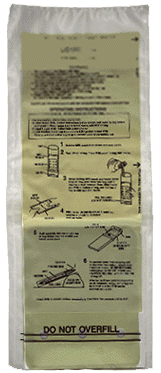
 |
General Info
Chemical
Equation:
Mg (s) +
2H2O (l) --------> Mg(OH)2 (s) + H2
(g) + 353kJ
Solid magnesium and
water yields solid magnesium hydroxide, hydrogen gas & 353 kilojoules
of heat energy
Source- Tocci, Viehland.
1996. Holt Chemistry Visualizing Matter. Austin, Texas: Holt, Rinehart
and Winston, Inc. pg. 271, 303 |
| 1. What is this
chemical reaction used for?
Source- Tocci, Viehland.
1996. Holt Chemistry Visualizing Matter. Austin, Texas: Holt, Rinehart
and Winston, Inc. pg. 271, 303 |
 |
 |
2.
How is the chemical reaction created?
Source- Tocci, Viehland.
1996. Holt Chemistry Visualizing Matter. Austin, Texas: Holt, Rinehart
and Winston, Inc. pg. 271, 303 |
3. How is stoichiometry
applied to this chemical reaction?
-
Stoichiometry is applied
to this reaction because we need to figure out how much water and Magnesium
will be needed for the meal to be heated. If too much or too little
of each is added, then the meal will not be heated
properly.
Source- Tocci, Viehland.
1996. Holt Chemistry Visualizing Matter. Austin, Texas: Holt, Rinehart
and Winston, Inc. pg. 271, 303
4. Give a specific
stoichiometric problem and solve it for each reactant and product.
-
About 353kJ of heat
energy is needed to heat the MRE to 60°C
Source- Tocci, Viehland.
1996. Holt Chemistry Visualizing Matter. Austin, Texas: Holt, Rinehart
and Winston, Inc. pg. 271
Calculation for the
amount of magnesium needed
353 kJ |
1 mol Mg |
24.0g Mg |
=
24.0g Mg |
|
353 kJ |
1 mol Mg |
|
Calculation for the
amount of water needed
353 kJ |
2 mol
H20 |
18g
H20 |
1mL
H20 |
= 36.0 mL H20 |
|
353 kJ |
1 mol
H20 |
1g
H20 |
|
Calculation for the
amount of magnesium hydroxide Mg(OH)2 produced
24.0g Mg |
1 mol Mg |
1 mol
Mg(OH)2 |
58
g Mg(OH)2 |
=58.0g Mg(OH)2 |
|
24.0g Mg |
1 mol Mg |
1 mol
Mg(OH)2 |
|
Calculation for the
amount of hydrogen gas H2 produced
24.0g Mg |
1 mol Mg |
1 mol
H2 |
2.0 g
H2 |
1000 mL
H2 |
=22254 mL H2 |
|
24.0g Mg |
1 mol Mg |
1 mol
H2 |
0.08987 g
H2 |
|
Source- Stecher,
Paul. 1968. The Merck Index- 8th edition. Rahway, NJ: Merck &
Co. Inc. pg. 543
5. Are any of
your reactants normally the excess or limiting reactant? Explain
why.
-
Magnesium is the limiting
reactant and is used up completely in the chemical reaction. H2O
is obviously the excess reactant. The amount of water that is needed should
be specified on the FRH bag because if we were to put more than the correct
amount, it would not heat the meal as well as you would like it to do (as
stated in #2).
Source- Tocci, Viehland.
1996. Holt Chemistry Visualizing Matter. Austin, Texas: Holt, Rinehart
and Winston, Inc. pg. 271, 303 |
 |
6. How much will the
main chemical reaction above cost to produce?
Cost for the amount
of Magnesium for the above reaction:
24.00 g Mg |
6.11 dollars |
=
5.86 dollars |
|
25 g Mg |
|
Flinn Chemical
& Biological Catalog Reference Manual 1999. IL: Flinn, 1999.
http://www.flinnsci.com
7. Are their any side
reactions or dangers from the original chemical reaction that must be compensated
for? If yes, how is it done?
-
Hydrogen gas is produced
in this reaction. Since it is very flammable, it is recommended that the
FRH should be used in a well ventilated area in which there is no risk
of fire. Fortunately, Hydrogen is able to quickly escape and no longer
be a danger for a long period of time. Another danger is that people can
get burned by the reaction of magnesium and water.
8.
Bibliography
 |
*N/A= No
Author(s) |
 |